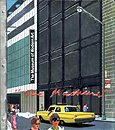|
Pontus Hulten was a museum director and pioneering figure for the reinvention of the modern art museum. He lead Centre Pompidou and also inspired LA MOCA, among others.
Contents:
beside every artwork is a symbol that refers to the group it is asigned to, being:
art
reconstruction
invention
car
camera
reconstruction
E.A.T.
"The machine as seen at the end of the mechanical age" is a catalogue that accompanied a seminal exhibition at The Museum of Modern Art, New York in 1968.
René d'Harnoncourt, then director of the MoMA had the idea for an exhibition of kinetic art but this idea was soon extended to new dimensions to an overview of the history of machines within an artistic context. Each of them is displayed on a single page with extensive black and white imagery.
Starting of with earliest depictions of machines by Dürer, da Vinci and contemporaries, similar to technical sketches of early flying aparatus', automata and wind powered carriages.
It then focusses on the development of the camera by examples from Etienne Jules Marey and the Lumiere brothers, Eadweard Muybridge, Théodore Maurisset, including many esoteric and unseen examples from other contemporaries.
It then proceeds to "Speed", trains and Marinetti and the Futurists, Duchamps (including an interesting text about the "great glass" or "the bride stripped bare" and its alchemical background)
Pages and pages of Picabia commented.
Kinetic art, optics and cinema: Duchamps again, Naum Gabo, Vladimir Tatlin, Raoul Hausmann, George Grosz, Kurt Schwitters, Hannah Höch, Max Ernst, Paul Klee, El Lissitzky Liubov Popova, Alexandre Vesnin, Oskar Schlemmer, Constructivists.
Cars: Ettore Bugatti, Buckminster Fuller,
Alexander Calder, Vladimir Tatlin, Man Ray,
Rube goldberg with cartoons of tooth-pulling machine.
Charles Chaplin, Man Ray, Alberto Giacometti with "the captured hand"
Amazing kinetic machines that draw randomly by Bruno Munari, Jean Tinguely,
After that depictions of cars as blow-up versions (Rauschenberg) or car wreck scuptures by Cesar Baldaccini.
Interesting: Robert Beer's kinetic plastic sheet continiously changing its shape by different, indiscernible mechanisms.
Thomas Shannon's interactive, kinetic sculpture involving a live plant.
Hans Haacke condensation sculpture.
Wen-Ying Tsai's "cybernetic" sculpture projecting onto ocillating rods.
Essentially a very good historical overview over machine/kinetic/cybernetic art - not only focussing on a few indivduals but also upon some unknown and "forgotten" ones.
|

